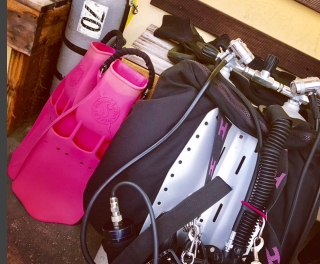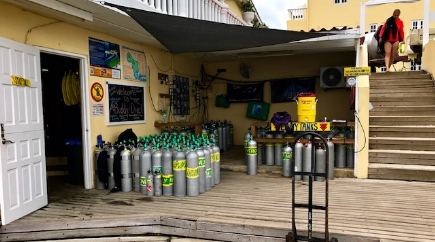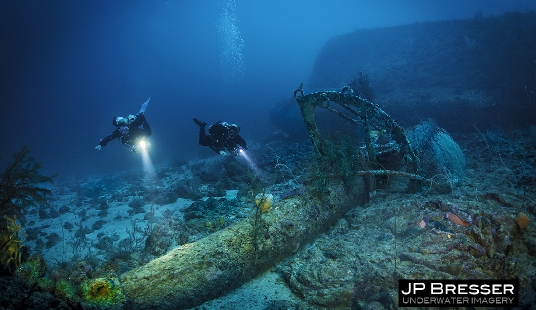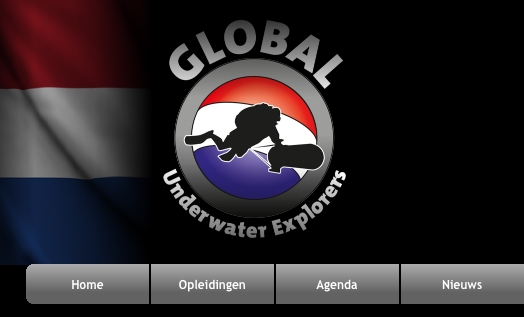|
- GUE TECH 1 on Bonaire
-
- After finishing my Rec3 class in 2015, I was sure I reached my highest level of competence in diving. In 2016, a Documentation Diver class in Croatia came by, together with a DPV1 class. Once I bought my Suex XJ 14 scooter and did numerous dives together with my (Tech1 trained) buddy, it slowly came to my mind that maybe a Tech1 level would be within my reach. And although it took some time to be convinced, 2017 would be my Tech1 year. After my buddy for the Croatia class cancelled, I received an even better opportunity: Tech1 with JP Bresser on Tropical Bonaire!
- I booked my flight to Bonaire; Anne-Marie Bresser took care of the rest of the logistics. And after a few days of relaxing, practicing drills with my buddy Alvaro, lots of S-drills, valve drills and reel-practice, I felt ready for my Tech1 class.
-
 - Day 1
- We started the Tech1 class with an introduction and found out that our team existed of the youngest Tech1 candidate ever (today was Alvaro’s 18th birthday) combined with probably one of the oldest female Tech1 students ever; myself ;-) After our personal introduction, completed with dive experience and work life, we started with the first part of Tech1 theory and 3 key words that popped up on a regular base during this class and supported us becoming a strong Tech1 diver: Team, Awareness and Efficiency. In the next hours, gas characteristics was on our Tech1 menu and corresponding knowledge on partial pressures, maximum depth and decompression times, average depth, SCR, CAT, turn pressures and gas switches were discussed.
- After a well earned lunch, we head out for our first dive. Before heading into the water, the daily steps of analyzing gas and labeling our tanks were done. Our Tech1 configuration for Bonaire consists of a Doubles Alu80 set for back-gas and an Alu80 stage for decompression gas. Since the water temperature is quite ok (28 degrees Celsius) we both dive a 5mm wetsuit with shorts/cargo pockets on top of it. At 9m meters we repeat our Fundamentals-skills like valve drill, S-drills, fin kicks, helicopter turns, backward kicks, gas-switch followed by an unconscious diver tow and another gas switch on our ascent. Needless to say, both of us have some improvement points as JP points out during the debrief of our dive. No worries, this is only day 1 and we are here to learn!
-
- Day2
- Day 2 starts with theory and field drills again: valve failures and how to solve them underwater. All 10 possible failures were discussed and practiced during our dry run, combined with the corresponding communication and checks. The remaining part of the day, we spend in the water (6-7 hour) where, while laying our reel, possible failure scenario’s are practiced and repeated. To make the teamwork a little bit more complex, Anne-Marie is joining today as our 3th team member. I am surprised how calm and relaxed I feel during these dives and ascents and feel how strong and stable a GUE team can function underwater, while solving problems. When, for the 2nd time, I am asked to give my mask to the instructor, Alvaro has to stabilize both Anne-Marie (who is just switching to her back-up mask) and myself, I am waiting patiently for Alvaro’s back-up mask to be pushed in my hands, before I can clear it and can enjoy some Bonaire underwater life again, I feel not too bad with myself. The ascents need some more work and that will be our goal for the next dives.
- During our last dives, the docks at Buddy Dive resort is secured and partially removed as the Tropical Storm Harvey will pass Bonaire on the north side and we aim to spend tomorrow with as much theory sessions mainly as diving might not be possible tomorrow.
-
- Day3
- Today is our “decompression day” due to the bulk of decompression theory that we learn today. We start with history on decompression, which I partly recognize from my Rec3 class followed by calculating decompression and pragmatic deco planning. I install a deco-app on my IPhone and Ipad, quite a handy tool now I know the background and how decompression works!
- We continue with our exams (which is actually quite easy after all theory we have discussed in the past days) and conclude the day with some homework and formulas that are noted in wetnotes. Harvey turns out to be nothing more then some swell, bigger waves and a very long, warm, windless day.
-
-
- Day4
-
- Today we start with scenario/ascent dives on 30 meters where the focus shifts from scenario’s to ascents and the team performs stronger every time. I feel comfortable in my dives and JP seems happy with the team performance too, as we are allowed to make our first experience dive later this afternoon. We will dive the wreck of the Hilma Hooker with trimix 30/30 and 100% oxygen as decogas.
- When entering the water from shore, there are quite some waves (a remainder of Harvey?) and while making my first steps in the water, I tumble over so need Alvaro to support me and get my fins on. Our dive proceeds as planned and we have enough time to swim through and around the wreck twice. When I coincidently bump my stage, the first stage is offset and gas is free flowing but I solve the issue in a few seconds. After reaching minimum gas, we start our ascent and add some extra time on the 6-meter stop. Leaving the water brings me another stumbling but with three strong men around me, I arrive safely at the shore and we conclude day 4 with a team dinner. So far so good!
-
 -
- Day5
- Two more experience dives are planned for today. In the morning we take the boat to the west side of Klein Bonaire, a 20-minute ride from Buddy Dive resort. After analyzing and labeling tanks we prepare our dive plan which brings us to 45 meters depth on trimix 21/35 with ean50 as our decompression gas. Craig (a Tech2 diver from Florida) joins as our 3th team member today. The reef on this side of Klein Bonaire is pristine with gorgeous corals and we enjoy this dive to the max. When reaching our minimum gas we start our ascent, following the reef, to 21 meters where we perform our gas switches and stop for 2 minutes. The ascents continues to 18 meters where Alvaro shoots a buoy after which we continue our ascent and stops according to our dive plan, all under the “never-missing-any-detail” eyes of JP.
- After lunch and a 3-hour surface interval, we head to the north of the Island to the Windjammer wreck. The Mari Bahn was one of the fastest sailing ships in her time and sunk in 1912 during a heavy storm. The wreck lies on her side on the sea bed at a depth of 60 meters, just next to the reef. This is the dive of all dives for wreck-lovers!
- Tanks are being analyzed and labeled again (trimix 18/45 and ean50) and all equipment is tested before we drive to the dive site. Alvaro and I go through our dive plan, we planned this dive for 51 meters of depth. After our GUE-EDGE (as on all dives) we drop to 3 meters for a final bubble check and descent to the Windjammer. Visibility is awesome and the wreck is fully covered with soft- and hard corals. JP shows a spot where we can do a photo shoot tomorrow (supposedly we pass the class and we are certified tech1 divers). If we pass the class will depend on our performance during this last experience dive and the swimtest. After reaching our minimum gas we show a text-book ascent with gas switch and all needed stops. On 6 meters we have our last decompression stop and stay there for 15 minutes. In the meantime we receive a big OK sign from JP and I smile from ear to ear. Wow, what a huge development we have made during this week and what a strong team we became!
-
 -
-
- Day 6
- We start early for our swim test. In the past weeks, I have been working hard on my stamina and am not worried about this part of the class. I finish the 400 meter swim under 9 minutes and we finalize this part of the class with a breath-hold swim.
- A quick shower and changing clothes and with my ipad under my arm, I am heading to the restaurant for the left overs of breakfast. We officially passed the class and after filling our QA at the GUE website, we receive our temporary c-card for tech1. I feel emotional and my eyes are wet. I never expected to participate in this class with so much fun and so less stress, and I made a huge step in my diving competence. Needless to say, I am extremely proud on myself!
- No time to loose: tanks analyzing and labeling, equipment checking and loading our truck for another dive and photo shoot on the Windjammer wreck. Before we enter the water we are briefed on the logistics and communication of photo dives, after which we take another go through the dive plan, a last GUE-EDGE and off we go for our first Tech1 dive after being a certified Tech1 diver. As planned, at the second mast we stop for pictures. Time flies while we dive the wreck and gas reserves too…. The ascent, gas switch and stops are performed even better then yesterday and I feel strong, competent and happy.
-
- Invited by our 3th team member for dinner, we debrief our days on Bonaire. Conclusion: Alvaro happy, me happy, JP happy…..
-
- Stans van Hoek
- GUE Tech1 diver
-
-
|
|

